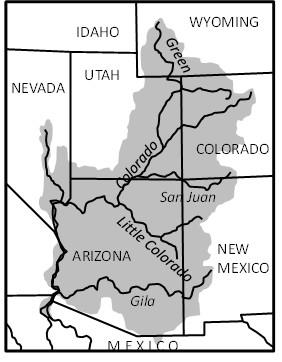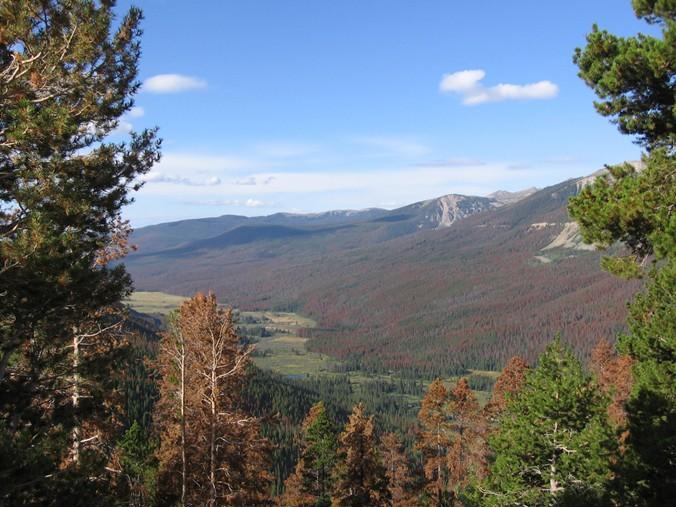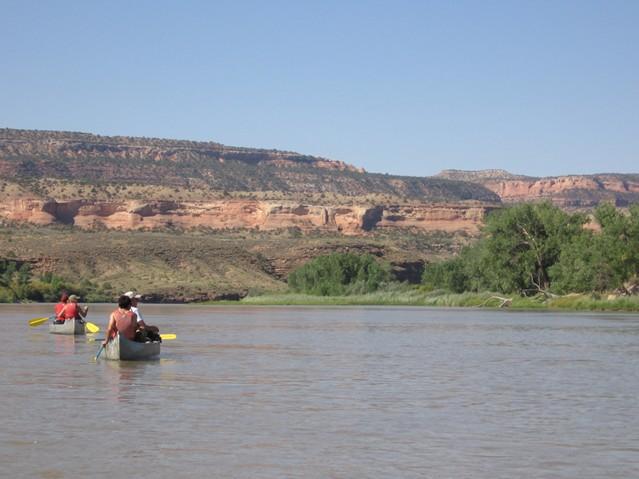Colorado River
Full Article
The Colorado is the premier river of the American Southwest. Rising in the mountains of Colorado and Wyoming, this river and its tributaries provide water and hydroelectric power for nearly 35 million people in the United States and Mexico, as well as habitat for several fish species found only in this drainage basin. Human use of water has severely altered the river, however, leading one writer to describe it as “a river no more.” The combined effects of numerous dams and extensive diversions of water from the river have so significantly altered natural flows that many of the plants and animals native to the river are gradually disappearing from the drainage basin, and most years the river no longer reaches the Pacific Ocean.
Vital Statistics
The Colorado River drains about 271,500 square miles of the southwestern United States and northwestern Mexico. Of these square miles, about 38,700 lie within the state boundaries of Colorado. The larger drainage basin is extremely diverse. The river crosses different regions, from the alpine tundra of the Rocky Mountains to the low-lying deserts of northern Mexico.
The Colorado has little stream flow compared with other rivers of similar size. Low flows reflect the predominantly dry climate of the drainage basin. Most of the river’s flow originates from snowmelt in the Rocky Mountain headwaters. Flow on the river has been measured at Lees Ferry, Arizona, since 1922. Average yearly flow at this site is 14,780 cubic feet per second, but this average value hides large fluctuations, from average flow during the June snowmelt peak of 32,300 cubic feet per second to winter low flows of 9,700 cubic feet per second.
During the second half of the twentieth century, flow was severely altered by the construction of nineteen major dams on the river and its primary tributaries and increasing diversions of water to croplands and cities. Peak flows were dramatically reduced and low flows were increased.
Diverse environments
The Colorado River originates on the western side of Rocky Mountain National Park in the Never Summer Mountains. The tributaries that join to form the Colorado start at elevations of 11,600 feet. The main river flows from 10,200 feet at La Poudre Pass, south through the Kawuneeche Valley and into Shadow Mountain Lake. From Shadow Mountain the river flows a short distance into Lake Granby, then continues southwestward until it crosses into Utah just west of Grand Junction at an elevation of about 4,400 feet.
The Colorado River within the state’s boundaries includes two very different regions: the mountainous headwaters and the high-elevation desert between Rocky Mountain National Park and the Colorado-Utah border. The mountainous headwaters average forty-five to fifty inches of precipitation each year, most of which falls as snow. Here, the Colorado is a mountain stream of cold, clear water flowing over cobbles and boulders. Trout wait in the pools for mayflies to alight briefly on the water surface. Some of these trout are Colorado River cutthroat trout (Oncorhynchus clarkii pleuriticus), a subspecies of special concern in Colorado. Forests of lodgepole pine, Douglas fir, and blue spruce line the river, with willow and aspen growing close to the water. Moose browse the woody shrubs growing in ponds created by beaver dams along the river. During the Ice Age, glaciers flowed down the Colorado River headwaters as far as today’s Shadow Mountain Lake.
As the Colorado River flows beyond Lake Granby, it rapidly becomes a river of the high desert. Average precipitation drops to fewer than fifteen inches per year in western Colorado, most of which falls as rain. Forests give way to open woodlands, grasslands, and then high desert of isolated bunch grasses and woody shrubs. These dry lands contribute little water to the river’s flow, but they do contribute sediment. Gradually, the river water takes on the reddish-brown hue that in 1605 led the Spanish explorer Juan de Oñate to call one of its tributaries the “Río Colorado.”
As it flows past Hot Sulphur Springs, Glenwood Springs, Rifle, and Grand Junction, the Colorado alternately runs through open country and narrow sandstone canyons weathered to hues of red, brown, and orange. The cold-water fish species of the higher elevations, which eat mostly invertebrates, give way at Glenwood Springs to omnivorous warm-water fishes such as suckers, minnows, and sunfish, which tolerate slow, turbid water. The high-desert canyons of the Colorado and its tributaries also support endangered fish species, including the humpback chub (Gila cypha), Colorado pikeminnow (Ptychocheilus lucius), roundtail chub (Gila robusta), and razorback sucker (Xyrauchen texanus). Some of these species are found only in the Colorado River basin.
Humans and the Colorado River
At the time of first European contact in the sixteenth century, all of the Colorado River drainage within Colorado was part of the territory of the Ute Indians. The river was not intensively manipulated until European settlement. Starting at the headwaters with the sixteen-mile-long Grand Ditch, some of the river’s water is diverted to the east side of the Continental Divide. Begun in 1890, this diversion was finished in 1936, but it was soon overshadowed by the Colorado–Big Thompson Project, which was completed in 1956. At present, about half of the water flowing down the South Platte River actually comes from the Colorado River. Water diverted from the Colorado River in Colorado now supports thousands of acres of croplands spread across the eastern and western parts of the state, as well as providing water for many cities.. Dams along the river and its tributaries also generate hydroelectric power.
The Colorado River is also an important source of recreational tourism, providing excellent sites for fishing, whitewater rafting, and kayaking. Much of this recreation takes place on public lands along the river. Portions of the mainstem Colorado lie within Rocky Mountain National Park and the White River National Forest. The entire drainage basin within Colorado includes five national forests, the Colorado National Monument, and other public lands.
Contemporary management of the river reflects the need to balance consumptive uses of the river – the dams and diversions that supply water and electricity for agricultural lands, municipalities, and industry – with preserving ecosystems, biodiversity, clean water, and fisheries, as well as other recreational activities that are only possible in a healthy riparian environment.










